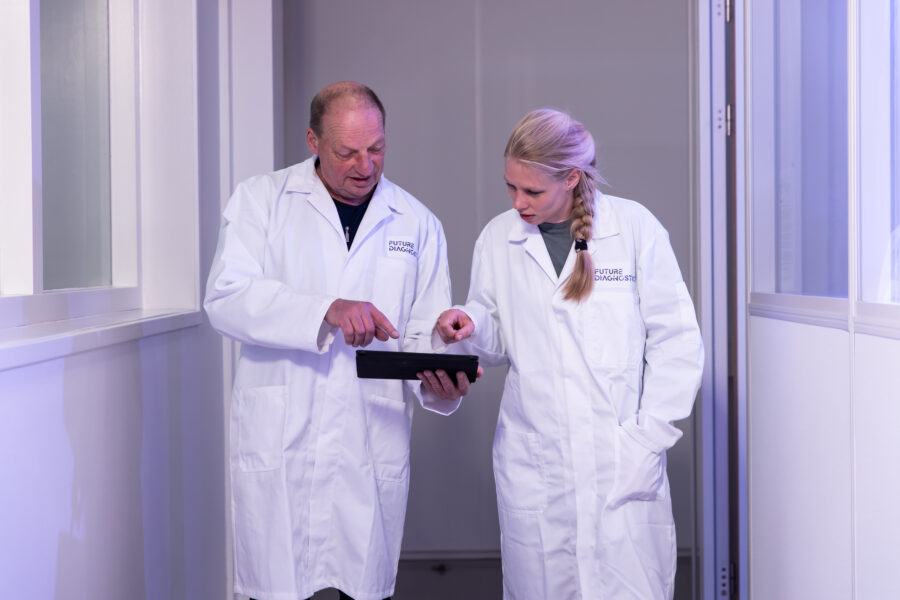The art of Bioconjugation
With state-of-the-art knowledge in the field of IVD assay development, Future Diagnostics also has extensive expertise in bioconjugation techniques. We offer this important component within assay development either as part of a comprehensive IVD manufacturing process, or as a separate service. In the process, we optimally link the desired molecules. And in addition, we also think about their final application. In this blog you will learn more about what bioconjugation is, and how a good conjugate is established.

Binding between tags and proteins
Conjugation: is the process of binding specific tags to an antibody, antigen or other protein. Using color or luminous molecules, an immunoassay can show whether or not a particular substance is present in a specific sample. In the case of an ELISA this is done by the addition of a substrate that reacts with the targeted enzyme in the form of color change. The following applies: the more bonds, the more intense the color.
Detection using fluorescent tracers and light-generating molecules is also an option. This is the case with fluorescent immunoassays (FIA) and chemiluminescence immunoassays (CLIA). Unlike the ELISA, the substrate used does not cause a color change, but rather a photon of light. This confirms the presence of a predetermined substance.
Process of linking
What is the optimal ratio of a label to an antibody? Which side of the protein lends itself best to linkage? And what form of chemistry is preferred? Future Diagnostics has the knowledge to apply different forms of heterobifunctional conjugation chemistry to meet customer expectations. Every one of our in-house experts will agree: Building a good conjugate is much more than just sticking some excipients together. We at Future Diagnostics know exactly what it takes to establish the intended link for a specific response. Efficient, controlled, and of high quality.
Some examples of different bioconjugation techniques:
- Chemiluminescence conjugates:
- Isoluminol
- Acridinium
- Enzyme conjugates:
- Horseradish peroxidase (HRP)
- Alkaline phosphatase (ALP)
- Biotin-/Streptavidin conjugates:
- Biotin-labeled proteins/haptens
- Streptavidin-labeled proteins/aptens
- Immunogens:
- Hapten protein conjugates
- Paramagnetic and nonmagnetic beads and particle conjugates:
- Magnetic beads – antigen/antibody conjugates
- Latex beads – antigen/antibody conjugates
- Gold nanoparticles
- Surface bioconjugates:
- Covalently coupled antibody microtiter plates
We also carry out quality checks on both incoming raw materials and intermediate products and the finished product with the utmost precision. The archiving of data and combining data is something that also benefits our customers. Because with the knowledge database we have built up over the past 25 years, we now have insight into all possible conjugation strategies and techniques. This allows us to easily and quickly identify the variables that affect the process. Over the years, Future Diagnostics has developed standard operational procedures for each conjugation technique; an experienced-based approach, so to speak.
Guaranteed high-quality materials
If you have been in this market for some time, another useful advantage reveals itself: Knowledge of suppliers and their materials. This prevents issues such as batch variation and purity problems with the selected excipients. And it enables informed judgments about who are stable parties within the industry.
Unlike when a customer selects materials themselves, outsourcing to a party with such knowledge can avoid delays and additional costs. We dare to state with certainty: our approach results in products that effortlessly remain fit for sale for 10 to 20 years.
Results guide Future Diagnostics work approach
It won’t come as a surprise: it is not costs, but results that guide our approach. In terms of the materials used, quality always takes precedence over a “favorable rate”. Because we believe that in many cases, penny wise is pound foolish. So, by extension, we also don’t choose the cheapest, but rather the best excipients and suppliers for the process.
To arrive at such a choice, we examine the quality of specific antibodies, antigens and labels. And we conduct special feasibility studies early on. So we can make an informed decision. After which, towards the end of the process, we also carry out a performance check to verify that what we have created actually works optimally in practice. With this structured approach, we are once again trying to create the highest achievable result for our clients.
Interested in any of the options listed? Or would you like something else conjugated? We will be happy to help you.